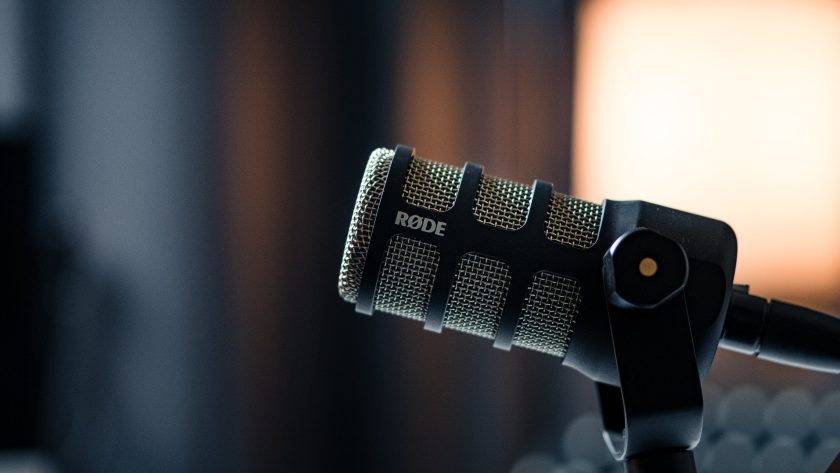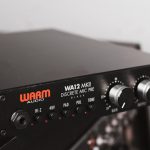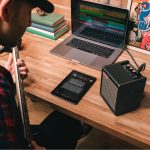Here are the best Rode microphones for vocals that are professionally engineered to deliver superb sound quality with extended dynamic range, vocal clarity and warmer sound signature. They are not as costly as a Neumann microphone and can make your voice sound more engaging and bigger with its classic warmth and silk smooth character.
Rode is an Australian audio technology company that was founded back in 1967 for their microphones and are now a famous household brand in the music recording industry for their microphones.
Today, their microphones are widely used around the world and considered the industry standard for studio recording, particularly with the higher-end rode NT1-A and NT2-A condenser mics that can capture an incredible amount of detail and depth to the voice. These microphones are designed for musicians to capture every single detail in the voice with engaging vocals and bright highs, and I highly recommend some of them for beginner musicians (particularly the Rode NT1 5th Generation mics).
If you are looking for one of the best Rode microphones that can really capture the essence of your voice and make your vocals sound bigger and more engaging, be sure to check out our top picks below!
1. RØDE NT1 5th Generation Large-diaphragm Condenser Microphone
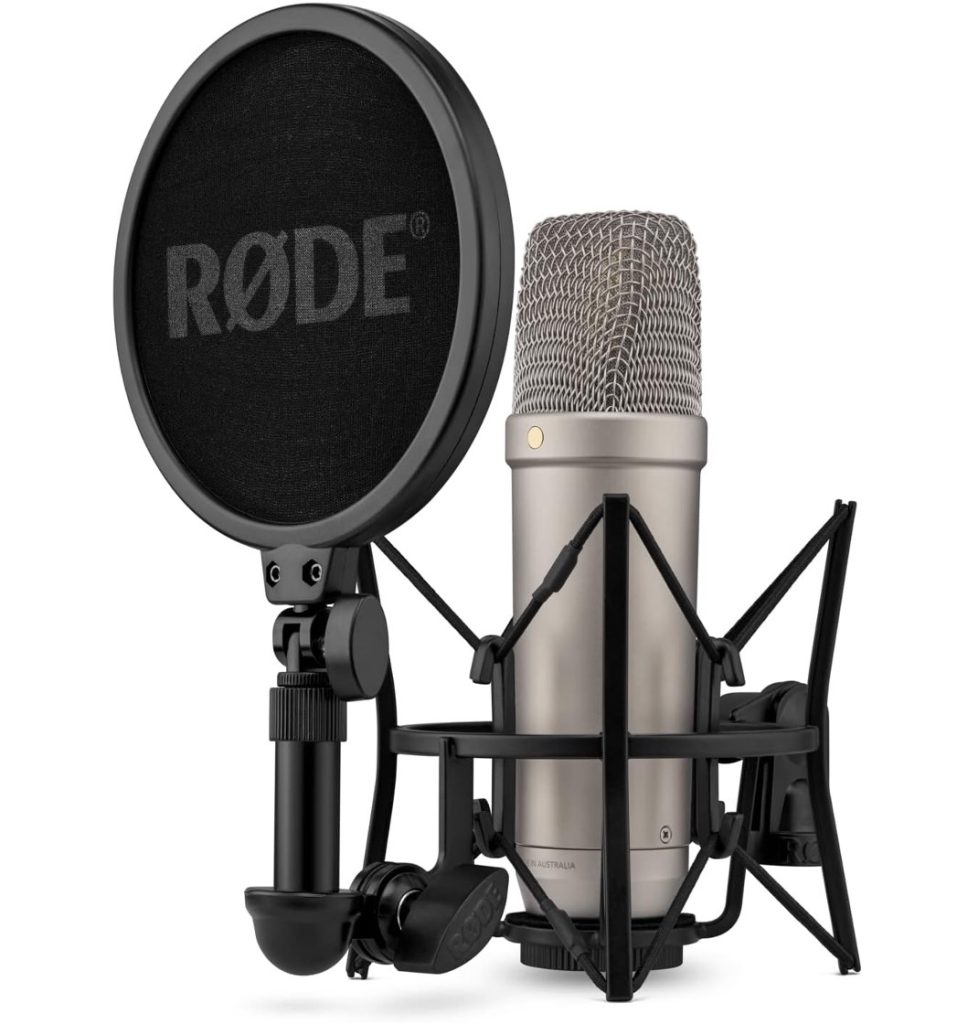
The latest and best Rode microphone for vocals…
The RØDE NT1 5th Generation is a large-diaphragm studio condenser microphone with a warm, silky sound signature and extremely low self-noise, making it great for recording crystal clear vocals and crisp highs. It features RØDE’s ultra-low-noise, high-gain Revolution Preamp and high-resolution (up to 192kHz) analog-to-digital conversion for clear digital recordings. The microphone has a frequency response of 20 Hz to 20 kHz, a max SPL of 142 dB, and a low self-noise of 4 dB (A-weighted). It can also handle high sound pressure levels, making them suitable for recording instruments such as piano and guitar.
The NT1 5th Generation offers both XLR and USB-C connectivity options, allowing it to be connected to an audio interface or mixer via XLR, or plug directly into a computer via USB for studio-grade sound in any setup. However, it lacks on-mic controls and a headphone jack. The microphone is very quiet and delivers professional sound quality, making it a very versatile microphone.
I really like the sound quality of the NT1 5th Generation microphone. The sound quality is crystal clear and crisp, and it manages to capture the richness of vocals with plenty of depth and warmth without any unwanted noise. Vocals sounded very warm with a silky character – it makes your vocals sound much bigger and more engaging. I have found this microphone to be one of my personal favorites especially for singing as it can capture subtle nuances and the tone in my voice. This microphone is very quiet and is great if you are recording in a home recording studio setting where the acoustics are less than optimal.
Overall, the RØDE NT1 5th Generation is a reliable and versatile large-diaphragm studio condenser microphone with a wide frequency response, low self-noise, and high SPL handling capability. It delivers a really warm and silky smooth sound especially for vocals, and can make your voice sound larger than life. Its USB-C and XLR connectivity options make it compatible with various recording setups, making it an excellent choice for home recording studios and also for recording guitar and piano.
2. Rode NT1-A Large Diaphragm Condenser Microphone
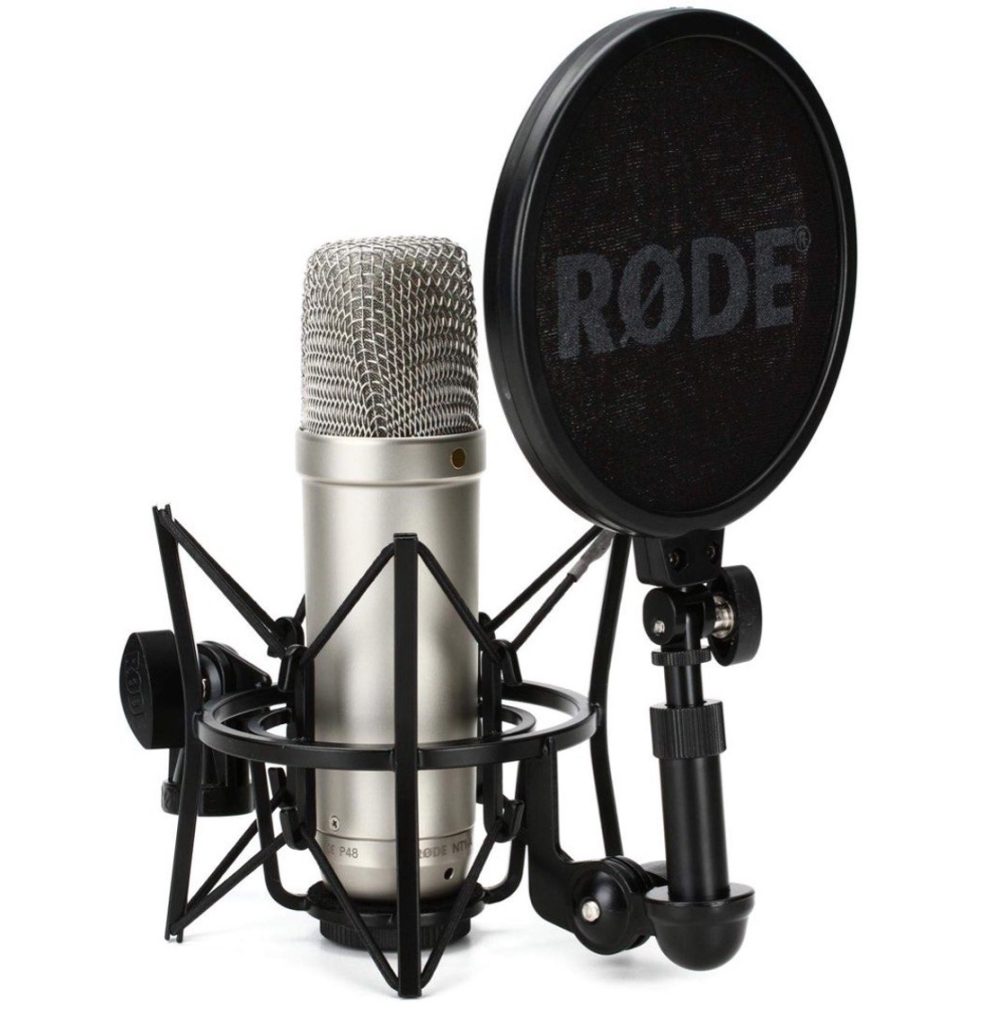
Hands down one of the best Rode microphone for silky smooth vocals…
The Rode NT1-A is a large-diaphragm studio condenser microphone with a cardioid polar pattern. It features a 1″ capsule with a gold-plated diaphragm and it delivers really silky smooth vocals that sound warm and engaging. The microphone has a self-noise of only 5dB(A), making it one of the quietest studio microphones in the world. It also has a wide dynamic range and ultra-low noise due to its transformerless surface mount circuitry.
One of the things that we liked about the NT1-A is that it has internal capsule shock mounting, which helps reduce handling noise and vibrations. The microphone can handle sound pressure levels (SPL) of up to 137dB without distorting, making it suitable for recording loud sources such as guitar cabinets. Its extended frequency response also allows it to capture subtle nuances of the sound with incredible accuracy.
The Rode NT1-A stands out for its low self-noise and wide dynamic range, making them great for home recording studios and also for recording instruments. While the original Rode NT1 has a slightly warmer sound, the Rode NT2-A offers additional polar patterns, pads, and high-pass filters. The Rode NT1000 has a sound that falls between the NT1 and the NT1-A, and the Rode NT2000 is a similar microphone to the NT1000 but with more features.
I really like to use the Rode NT1-A for recording vocals due to its engaging and clear sound quality and low self-noise. Its smooth and silky character brings every performance to life, while its extended frequency response ensures that every nuance is captured with incredible accuracy. The microphone also comes with a studio-grade SM6 shock mount and pop filter, which help in achieving clean and plosive-free recordings.
3. Rode NT2-A Studio Microphone
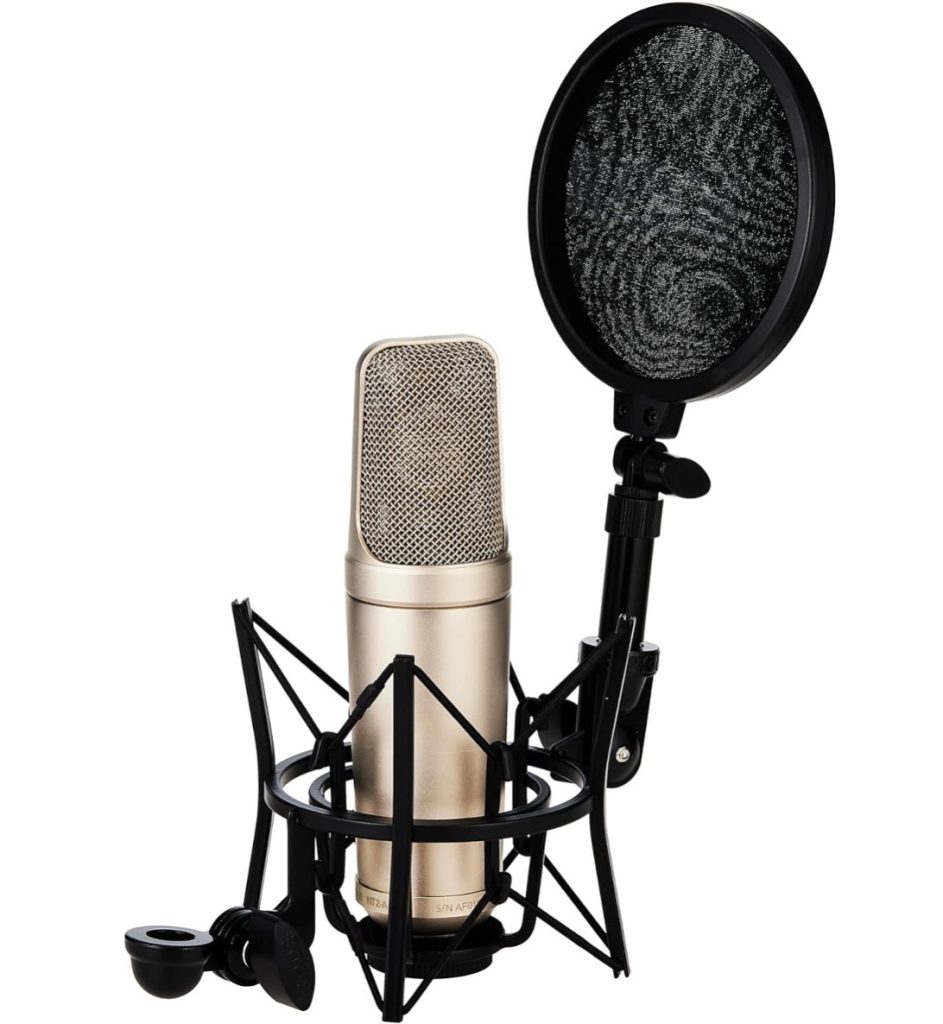
An excellent condenser microphone for recording vocals…
The Rode NT2-A condenser microphone is a versatile mic for home recording studios that delivers really nice vocals with crisp highs. It features a large 1-inch HF1 gold-sputtered capsule, which contributes to its excellent sound reproduction. The microphone offers a three-position variable polar pattern (omni, cardioid, and figure 8) and a three-position variable high-pass filter (flat, 40 Hz, and 80 Hz), allowing for flexibility in capturing different sound sources. Additionally, it has a three-position variable pad (0 dB, -5 dB, and -10 dB) to handle high sound pressure levels.
One of the main advantages of the Rode NT2-A is its versatility. It can be used for various applications, including recording vocals, background harmonies, acoustic guitars, drums, and pianos. The microphone’s internal capsule shock mounting helps reduce handling noise and vibrations, resulting in cleaner recordings. It also has a sleek and durable design, with a rounded metal casing and a metal grille over the diaphragm.
Compared to the Rode NT1-A, the NT2-A offers more advanced features at a higher cost. While the NT1-A is known for its low self-noise and affordability, the NT2-A provides additional polar pattern options, high-pass filters, and pad settings, making it a more versatile choice for different recording techniques. It is the more “advanced” microphone that you would get for a professional recording studio.
If you are looking for a microphone specifically for recording vocals, the Rode NT2-A is an excellent option. Its large diaphragm and cardioid polar pattern help capture detailed and authentic vocal performances, while the variable pad and high-pass filter settings allow for customization based on the singer’s proximity to the microphone and the room’s acoustics. The microphone’s low self-noise and high sensitivity contribute to its ability to capture subtle vocal nuances, making it a reliable choice for professional-sounding vocal recordings in a home studio setting.
4. Rode PodMic Dynamic Microphone
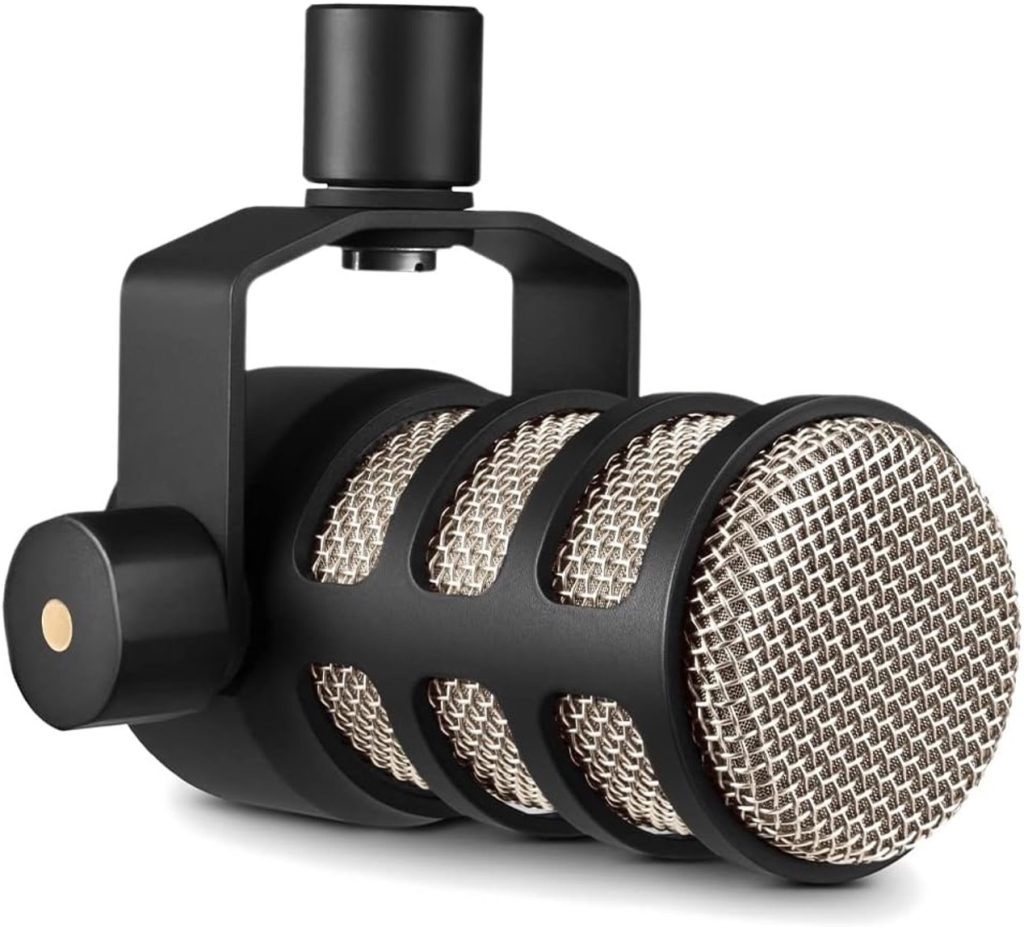
One of the best Rode mics for podcasting…
The Rode PodMic is a broadcast-quality dynamic microphone optimized for podcasting and livestreaming, and delivers on-point speech performance with virtually no coloration. It features a dynamic acoustic principle and a cardioid polar pattern, which helps to capture sound from the front while minimizing background noise. The microphone has a frequency range of 20Hz to 20kHz, allowing it to capture a wide range of audio frequencies for vocals.
One of the key features of the Rode PodMic is its internal pop filter which helps to minimize plosives and improve the overall sound quality. I found this to be a really useful feature while podcasting as it can filter out plosive sounds. The microphone also has an internal shock mount, which reduces vibrations and ensures a clear and balanced sound. The Rode PodMic is compatible with a range of accessories, including the PSA1, PSA1+, and DS1, which offer additional flexibility and convenience during recording.
I found the Rode PodMic a solid all-rounder with really good vocal reproduction for broadcasting, and it also comes with additional features that other Rode mics do not have. For example, the Rode Procaster Broadcast Dynamic Vocal Microphone offers a similar frequency range and output impedance but lacks the internal pop filter and shock mount found in the PodMic. On the other hand, the Rode NT-USB Versatile Studio-Quality Condenser USB Microphone is a USB microphone that offers a different set of features and is not optimized for podcasting and speech applications like the PodMic.
If you are looking for a microphone for recording vocals in a home recording studio context, we recommend the Rode PodMic. Its optimized design for podcasting and speech applications, along with its rich, balanced sound and internal pop filter, make it an excellent choice for capturing clear and professional-quality vocals. Additionally, the microphone’s compatibility with the RODECaster Pro podcast production studio and other microphone interfaces allows you to setup everything conveniently in one go. This is a really good microphone for beginners to get especially if you are into broadcasting.
5. Rode Procaster Broadcast Microphone
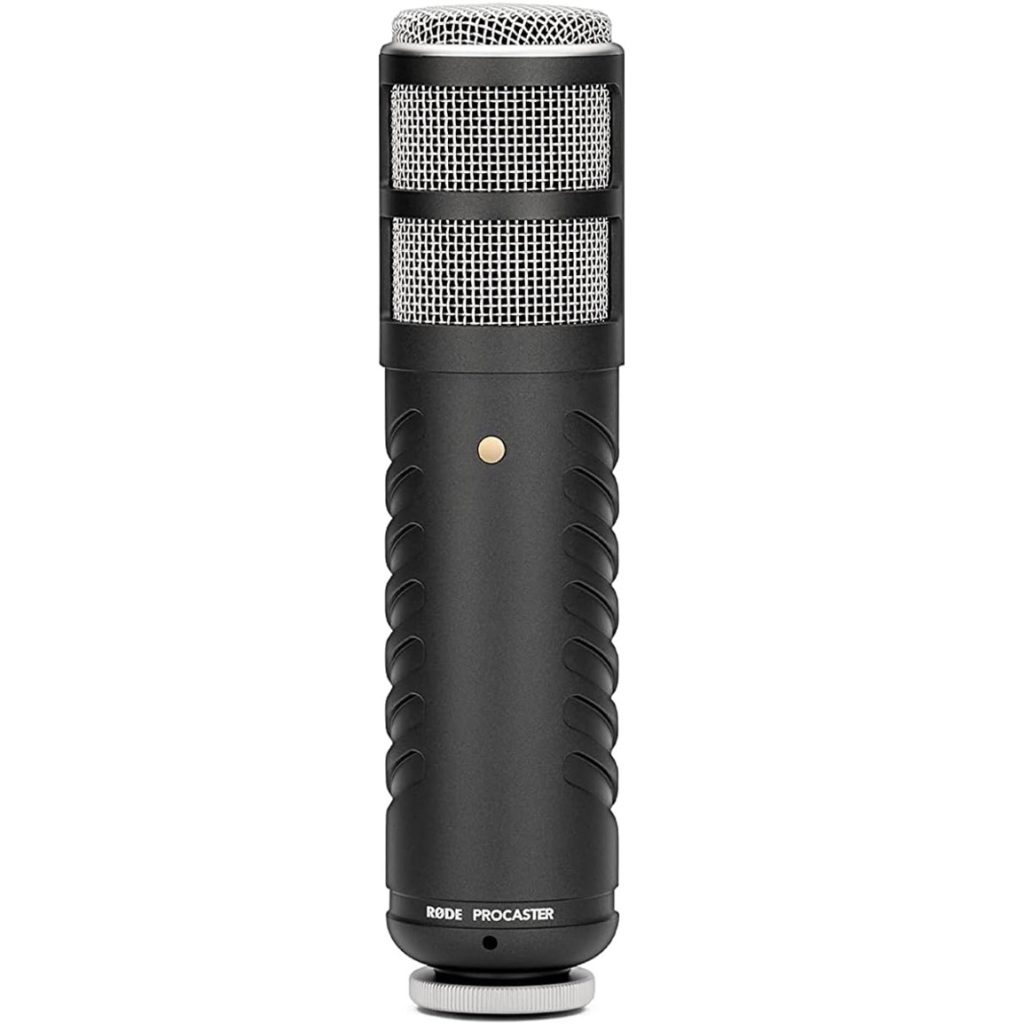
One of the best mics for broadcasting studios…
The Rode Procaster Broadcast Dynamic Vocal Microphone is a professional-quality microphone designed specifically for speech and vocal broadcasting. It features a dynamic acoustic principle and a cardioid polar pattern, which provides excellent sound reproduction and ambient noise rejection. The microphone has a frequency range of 75Hz – 18kHz, an output connection of XLR 3-pin, and an output impedance of 320Ω. Its sensitivity is -56.0dB re 1 Volt/Pascal (1.60mV @ 94 dB SPL) +/- 2 dB @ 1kHz.
When we tested the Rode Procaster, we found it delivers a rich and transparent sound with a flat midrange and a smooth transition, although the lows can be a bit hyped and may require a basic low cut filter to achieve the desired clarity. The Procaster effectively rejects room noise and minimizes popping, but it may feel unwieldy and require a swivel arm with a spider mount for optimal positioning. This microphone also does not have on-device controls like some similar models, and it needs a fairly beefy interface to power it.
Compared to the Shure SM7B, another popular dynamic microphone for broadcasting and recording vocals, we felt that the Procaster has a slightly wider frequency range and a lower output impedance. In terms of design, the Procaster is more of a stationary mic and may not be as suitable for mobile recording as some other models. However, its superior ambient noise rejection make it an ideal choice for recording vocals in a home studio or broadcast setting.
If you are looking for a reliable and high-quality microphone for recording vocals, we highly recommend considering the Rode Procaster microphone. Its frequency response, sound quality, and ambient noise rejection capabilities make it a suitable option for podcasting, voice-over work, and other speech-driven applications. While it may require some basic EQ adjustments and a sturdy arm for optimal performance, the Procaster offers excellent value for its price and is built to last.
6. Rode NT-USB+ Condenser Microphone
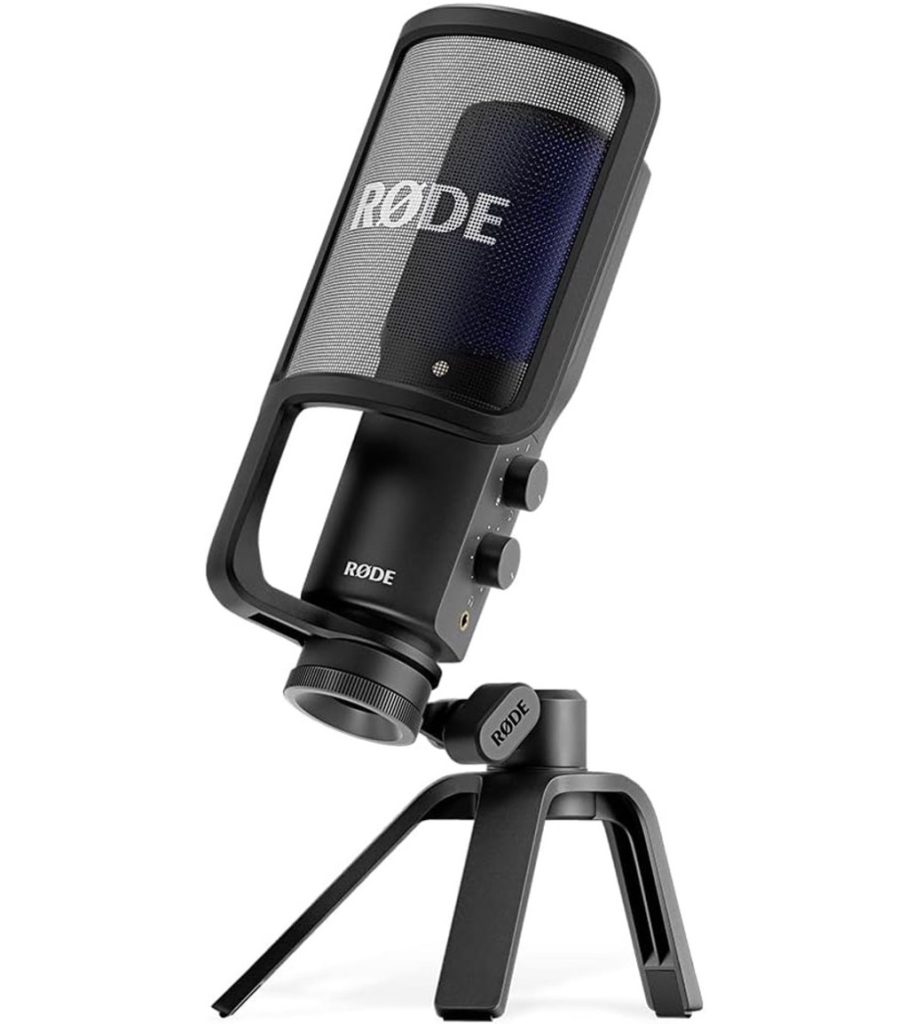
A really good USB condenser microphone for a variety of recording applications…
The Rode NT-USB+ is a professional USB microphone with a studio-grade condenser capsule that delivers really clear and clean vocals. It features an ultra-low-noise, high-gain Revolution Preamp for pristine sound without the noise. The microphone has a high-power headphone output with zero-latency monitoring and versatile controls for clear self-recording or streaming. It also offers powerful APHEX audio processing accessible via Rode Central software, including the legendary Aural Exciter and Big Bottom processors.
One of the things that I liked about the mic is that the USB-C connectivity provides hi-res audio (48kHz / 24-bit) and is compatible with computers and smartphone devices. Additionally, it comes with a detachable pop filter and desktop stand, making it an all-in-one desktop studio solution that doesn’t require any additional pieces. The class-compliant USB output works seamlessly with computers and mobile devices, making it great for podcasting and music recording to Zoom calls.
The Rode NT-USB+ comes with a high-gain Revolution Preamp and powerful APHEX audio processing, which allows it to deliver pristine sound quality. The high-power headphone output with zero-latency monitoring and versatile controls is also a significant advantage for clear self-recording or streaming. The microphone’s USB-C connectivity and compatibility with various devices make it a versatile and convenient option for different recording applications. Additionally, the included detachable pop filter and desktop stand provide an all-in-one solution for desktop studio recording so you don’t have to purchase an additional pop-filter.
Having said that, the Rode NT-USB+ lacks on-mic gain control, which may be a limitation for some users. It may also struggle with louder audio sources, and its bit depth/sample rate is studio-quality but not high-res (as expected from a USB mic). Despite these limitations, the microphone offers a high level of performance and versatility for various recording applications.
Overall, Rode NT-USB+ is really good USB condenser mic that is easy to setup and delivers crisp and clean vocals. The high-power headphone output with zero-latency monitoring and versatile controls also make it a suitable option for clear self-recording or streaming. Additionally, its USB-C connectivity makes it very easy to setup and is essentially a plug and play microphone. I highly recommend this mic for beginners if you are thinking of setting up a home recording studio.
7. Rode XCM-50 USB Condenser Microphone
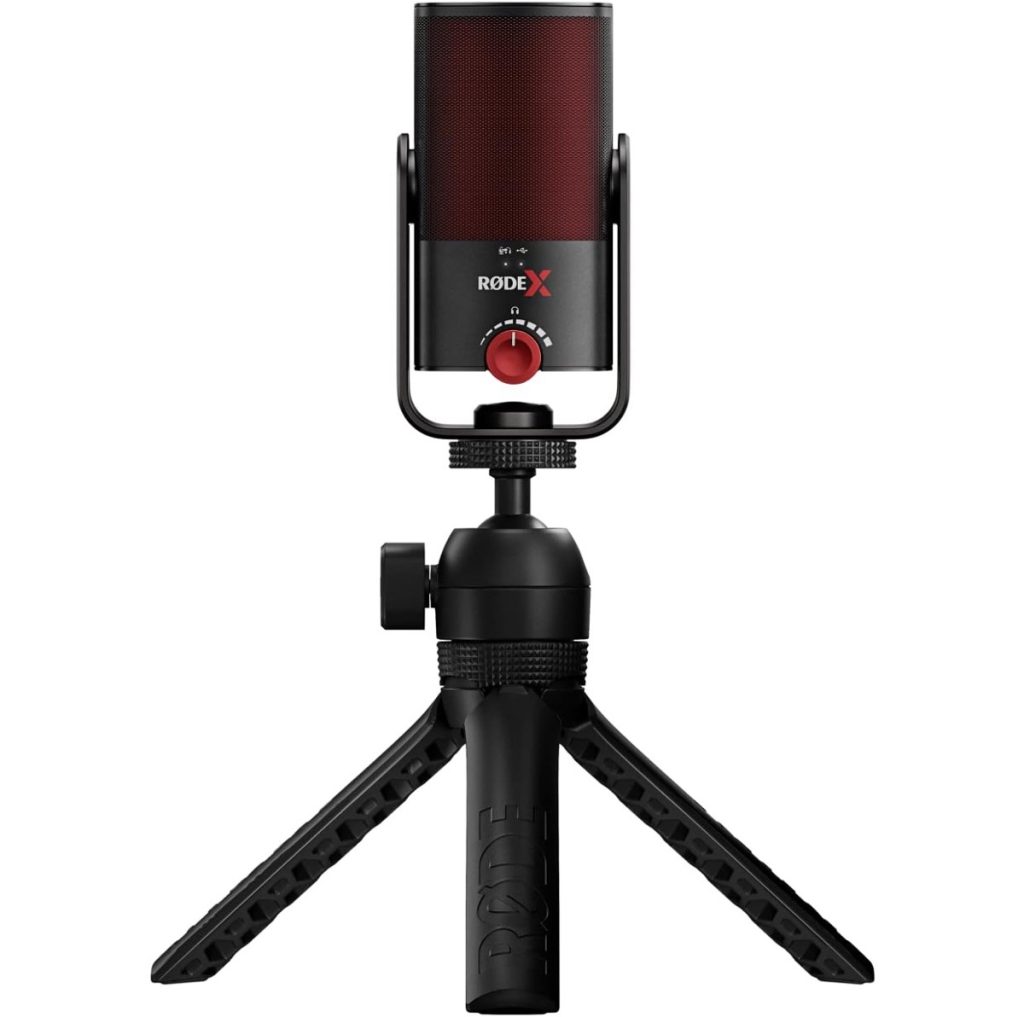
One of the best Rode microphones for live streaming…
The Rode XCM-50 is a professional condenser USB microphone optimized for live streaming and gaming. It features a tight cardioid polar pattern that helps reduce background noise, making it ideal for recording vocals. The microphone has a full-range 20 – 20,000 Hz frequency response and records 24-bit/48 kHz audio, ensuring highly detailed sound quality. It also offers plug-and-play USB connectivity, making it easy to use without the need for additional equipment.
One of the things that I like about the Rode XCM-50 is that it has better internal DSP and comes with UNIFY virtual mixing software which provides advanced APHEX voice processing and voice FX like reverb, delay, pitch-shifting, and robot. The microphone’s 360-degree swing mount and included tripod allow for easy positioning to achieve the best sound possible. Additionally, the zero-latency headphone output, complete with level control and mute button, provides a crisp and deep audio recording that captures subtle nuances your vocals.
Furthermore, the Rode XCM-50 also comes with an internal pop shield and capsule shock mount, which helps to reduce plosive sounds while recording vocals. Vocals sound loud and clear during live streams, making it a great choice for streamers and content creators who require a compact and functional mic with studio-quality sound at home.
If you are looking for a microphone specifically for live streaming vocals, we recommend the Rode XCM-50 for its detailed sound signature, tight cardioid polar pattern, and advanced features. The microphone’s internal DSP and included UNIFY virtual mixing software and zero-latency headphone output makes it a versatile and user-friendly option for home recording studios. The 360-degree swing mount and included tripod also offer flexibility in positioning which makes it very easy to setup straight out of the box.
8. Rode K2 Multi-Pattern Dual Valve Condenser Microphone
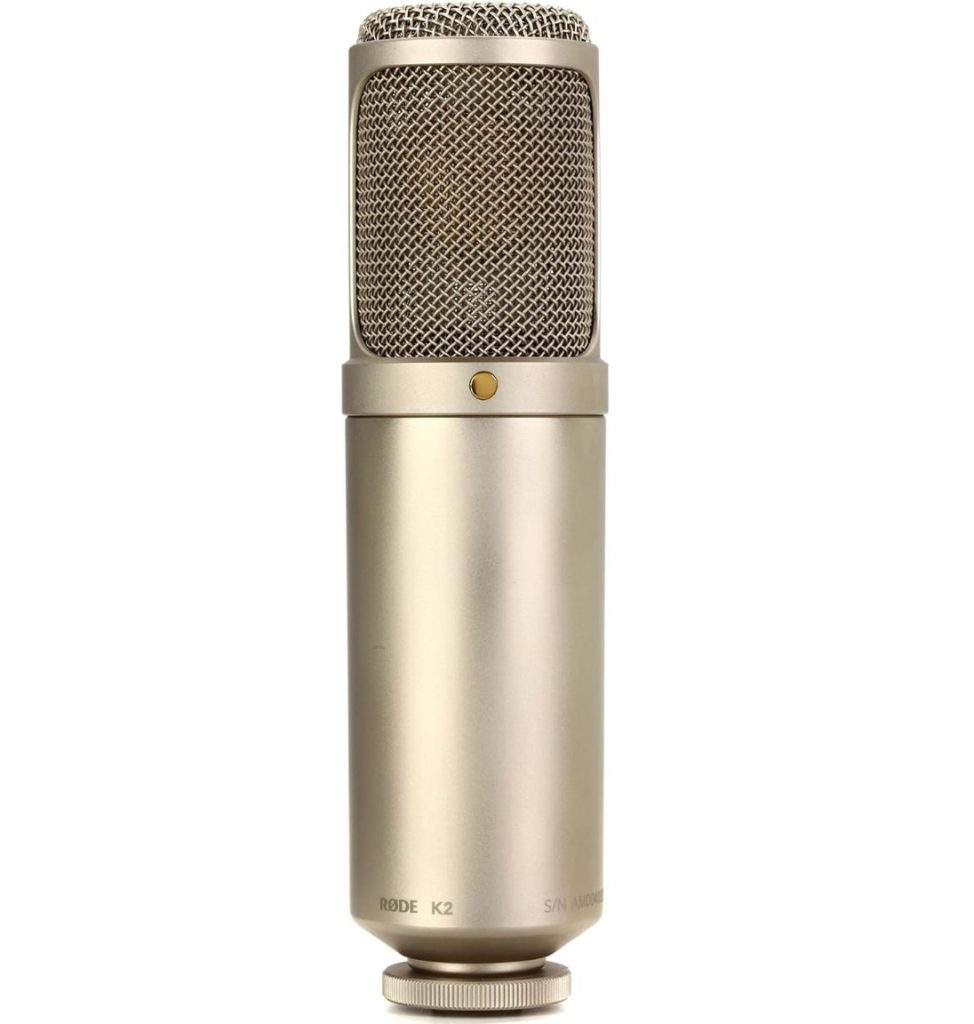
The Rode K2 Multi-Pattern Dual Condenser Valve Microphone is a high-quality microphone suitable for various recording purposes, particularly in a home recording studio context. It features a large 1″ capsule with a gold sputtered diaphragm and internal shock mounting, which contribute to its ultra-low noise and wide dynamic range. The microphone also boasts Class ‘A’ valve circuitry and a hand-selected and graded 6922 twin-triode valve, ensuring optimal performance.
Compared with the Neumann TLM 103, the Rode K2 has a warmer and natural sound which makes it sound more “vintage” due to its Class ‘A’ valve circuitry and large diaphragm. In contrast, the Neumann TLM 103 delivers clearer and detailed sound without any warm coloration, although the TLM 103 has better detailed pickup than the Rode K2.
Personally, I found the Rode K2 microphone to have a rich openness that is rarely found in other microphones. The Rode K2 captures even the most gentile transients and spectral shifts, and delivers a tonally balanced sound that feels silky and warm – the sound feels uniquely vintage and very clear. Its ultra-low noise and wide dynamic range allow it to capture subtle details and dynamics, making the recorded vocals are clear and present. Furthermore, the internal shock mounting helps to reduce unwanted vibration and noise, further enhancing the overall sound quality.
If you are looking for a really good condenser mic with its own personal character, the Rode K2 Multi-Pattern Dual Condenser Valve Microphone comes highly recommended. Its unique frequency response and valve circuitry make it stand out among other condenser microphones in the market, and delivers a warm and natural sound with a really good “vintage” feel that captures the essence of your voice.
9. Rode NT1000 Large-Diaphragm Condenser Microphone
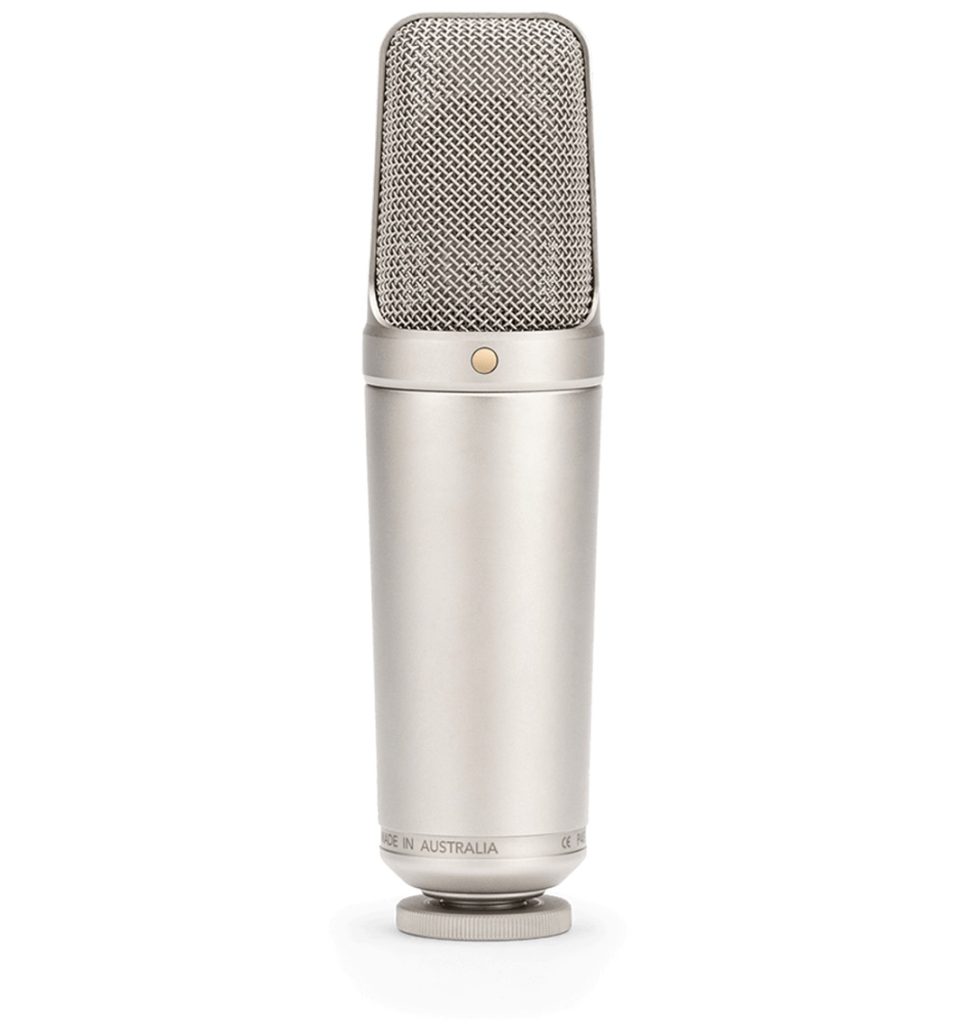
One of the most versatile Rode microphones for vocals and instruments…
The Rode NT1000 Large-Diaphragm Condenser Microphone is a high-performance microphone that records exceptionally clear vocals and can even be used to record instruments such as a grand piano and drum overheads. The microphone features ultra-low 6dBA self-noise and transformerless circuitry, providing exceptional clarity and detail in recordings. Furthermore, the NT1000 is equipped with internal capsule shock mounting, which reduces the transmission of mechanical noise and vibration.
One of the key advantages of the Rode NT1000 is its exceptional performance when recording both vocals and instruments. Its wide frequency response and low self-noise make it a reliable choice for capturing clear and detailed sound. However, you may need to use an additional pop filter with the NT1000 due to its sensitivity and pickup.
I would say that the Rode NT1000 has an excellent balance of sensitivity and gives vocals warmth and depth that is often only heard in higher end condenser microphones. Vocals sound really engaging and bright, and you can also use this microphone to record instruments such as guitar and piano and get silky smooth pickup with distinct clarity in the upper frequencies ranges.
When we compared this microphone against the Neumann TLM 103, the Rode NT1000 exhibits a slightly different sound character, with the TLM 103 delivering very clear and detailed sound, while the NT1000 offers a more versatile and open sound that feels “spacious”. Similarly, compared to the AKG C414, the NT1000 provides a different tonal quality, with the C414 known for its multiple polar patterns and wide frequency response, while the NT1000 offers a more focused and detailed sound.
Overall, the Rode NT1000 Large-Diaphragm Condenser Microphone is a really versatile microphone for recording vocals and instruments in a home recording studio context. Its versatile sound character and exceptional clarity make it a reliable choice for a wide range of applications, from vocals to grand piano and drum overheads. However, its sensitivity to plosive sounds may require the use of a pop filter so you need to factor that into considering if you choose this microphone.
10. Rode NTK Large-Diaphragm Tube Condenser Microphone
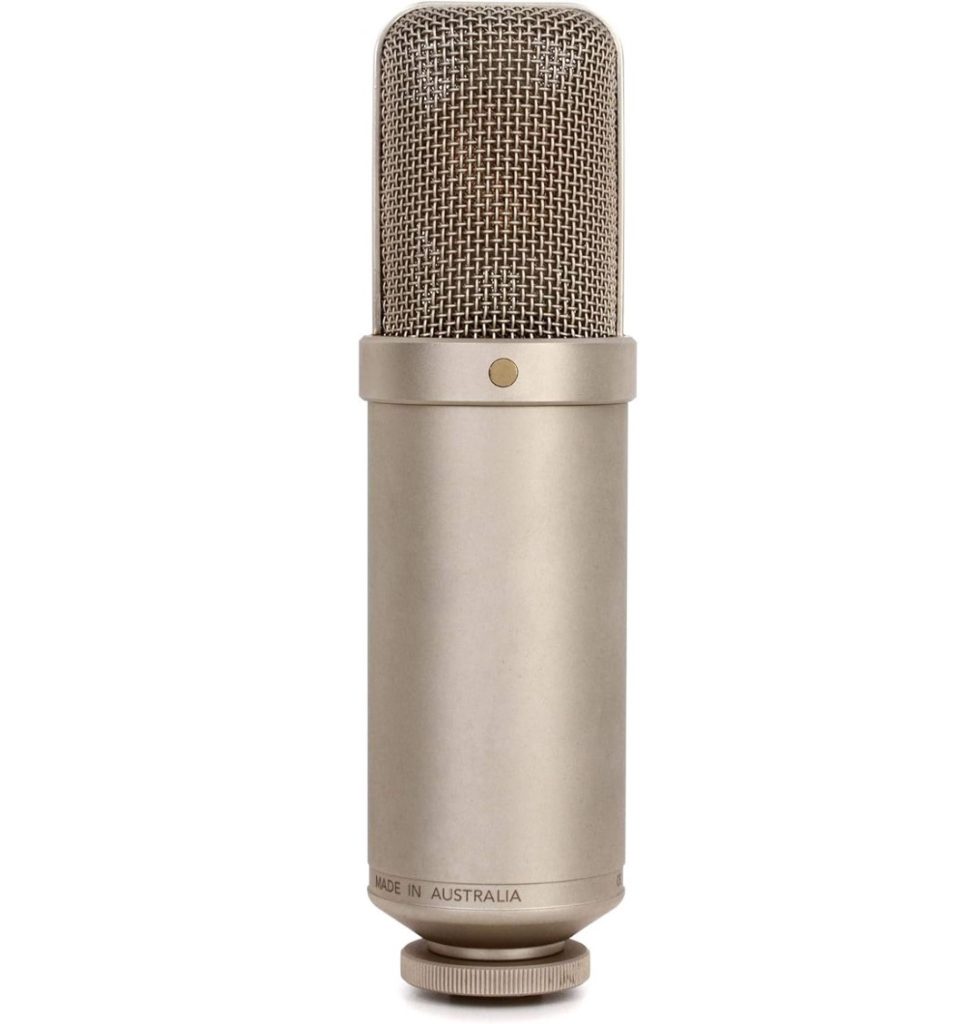
One of the best Rode microphones with a very wide dynamic range…
The Rode NTK Large-Diaphragm Tube Condenser Microphone is a professional-grade recording microphone that comes with a sizeable 1″ gold-sputtered condenser capsule and a hand-selected 6922 twin-triode valve that reinforces its class ‘A’ valve circuitry. It’s crafted to offer a broad dynamic range with minimal noise, and its variable polar patterns make it adaptable to a variety of sound sources such as vocals, guitars, pianos, and drums.
The Rode NTK microphone is capable of delivering a crisp and warm sound profile, which retains a full-bodied character and detailed precision across audio spectrums. The highs are crystal clear with really nice midranges that sound warm, and the lows are smooth and well-defined. You will need very little EQ with this microphone as it captures your voice exactly the way it sounds and makes it sound more engaging. It does not have a flat frequency response, but makes your vocals sound warmer. It also has a wide frequency response of 20Hz to 20kHz and can handle maximum input levels up to 140dB without distortion which provides true-to-source audio capture.
The Rode NTK has a durable build with its hand-welded and heat-treated steel mesh head. Compared to the Rode M3 which is a small-diaphragm cardioid condenser microphone that delivers natural vocal capture, the NTK’s larger diaphragm and valve amplification clearly provide a sound with more depth and warmth. The Rode NTK microphone delivers really crisp sound performance and excellent highs particularly for vocal performances.
If you are aiming to record high-fidelity vocal tracks at home, the Rode NTK is one of the best condenser microphones you can get. It combines top-tier components with a dynamic performance range and almost negligible noise levels, and captures the subtle details and nuances in your vocals. The variable polar pattern also makes this microphone pretty versatile and you can adjust the polar pattern to fit your recording needs. Overall, it’s a highly recommend microphone that delivers a wide dynamic range with really clean sound performance.
Next Steps
If you are a beginner musician looking for a beginner friendly microphone on a budget, or want to know what is the difference between a dynamic and condenser microphone, be sure to check out our guides below:
